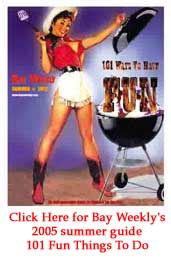) |
Crab Catch
by M.L. Faunce |
Non-filter feeders avoid dead zones while passing through
The Chesapeake Bay is called a national treasure, but regionally it’s better known as an estuary in need of saving. Save the Bay is more than a motto of our largest regional conservation organization; it’s become the rallying cry of politicians, environmentalists, blue-ribbon commissions, scientists and ordinary folks who give up lawns for meadows, pavement for the pervious.
Back in 1971, when William Warner won a Pulitzer Prize for Beautiful Swimmers — his engaging study of watermen, crabs and natural history of Chesapeake Bay — the Bay was said to provide “more crabs for human consumption than any other body of water in the world.”
Now in the sultry days of summer, we’d rather focus on the positives: more underwater grasses in some areas, more baby crabs this spring. We’d rather enjoy backyard crab feasts and not think too deeply. But if you’re a crabber or a fisherman, kayaker or recreational boater, biologist or fossiler — anyone who spends time around the water — you know different. In warm weather and warm water, oxygen levels in the Bay plummet and nutrients — nitrogen and phosphorous from lawns, farms and sewage systems — soar, resulting in algae blooms and dead zones. Not what we want to think about as we sit down to our crabs.
On the dry, breezy weekend of July 4, I kayaked the creeks of West River. With visibility only inches from the shoreline, that trip was a little like watching the canary in the coal mine for summer 2005, which Bay scientists had already predicted could rank among the five worst summers in the past 20 years.
Dead zones were on Bay Weekly reader Sonia Linebaugh’s mind when she asked, “With all the talk about dead zones and shellfishing bans in the Bay, how do we know our crabs, and clams, too, are safe to eat? Where in the Chesapeake Bay are our watermen finding crabs to harvest?” (See Letters in this issue.)
Despite alarming forecasts on oxygen starved water, finally there are plenty of crabs, and from areas not affected by summer woes.
“We have a glut on,” said Captain Russell Dize of Tilghman Island. “We started off with no crabs; now we have more than we know what to do with.”
Dize says dead zones are all over the Bay, mostly in the deepest channel of the middle Bay and the deepest part of the rivers. They will get worse as the summer goes on. “It doesn’t much affect us where crabbing is done, though it spills over to the shoals every once in a while,” he said.
Even plenty doesn’t relieve the woes of a Maryland crabber.
“We had a decent market,” Dize reflects, “but now there’s crabs everywhere,” bringing competition from close by Delaware Bay crabs as well as those shipped from Louisiana, North Carolina and Texas. “Everyone ships into the Bay,” he says as a Maryland crabber pulls up to his dock with a surfeit of what we’re talking about.
Despite Dize’s reassurance, consumers like Linebaugh can’t help but notice the flood of newspaper stories with bad news about the water quality in a year now said to have the largest oxygen-depleted water area ever recorded in the Chesapeake Bay.
I also posed Linebaugh’s questions to Mitch Tarnowski, clam biologist for Maryland Department of Natural Resources’ shellfish program.
“Dead zones tend to be in deeper water and are areas of low or no oxygen. Essentially you wouldn’t find anything living there,” he said. “As far as dead zones and seafood, the dead zones shouldn’t be a concern because the animals wouldn’t be in there.”
To keep shellfish beds safe, Maryland Department of Environment checks for bacterial counts in the water column. Closures when levels are too high assure that beds of mollusks — filter feeders like clams and oysters — meet standards for food products.
“Crabs are not filter feeders as they pass through, so there’s not an issue about eating them,” Tarnowski said.
Interested in knowing more about dead zones in the Bay? Check the Chesapeake Bay Foundation at www.cbf.org
Maryland Department of Environment is a good source of information on water quality in the Chesapeake region: www.eyesonthebay.net.
This Week’s Crab Sources
Joe’s Seafood, Severna Park
Crabs from Louisiana and Maryland
- Extra Large Males: $58 the dozen
- Large Males: $40 the dozen
- Medium Males: $30 the dozen
- Regular Males: $15 the dozen
Crab Corner, Edgewater
Crabs from Kent Island
Mel’s Crabs, Prince Frederick
- No. 1 Males: $19.75 the dozen


